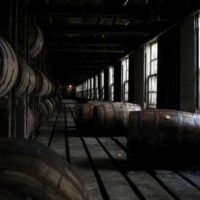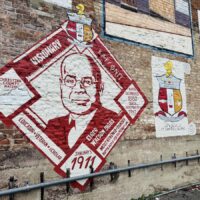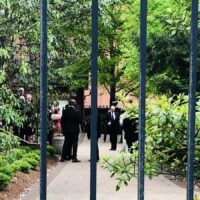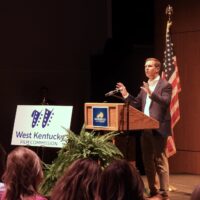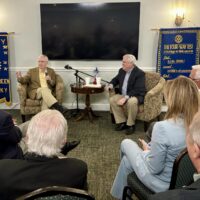They are dressed in their finest church clothes, but they are ready for action. Easter action, that is. I imagine each one inching his or her way forward, nudging, pushing, to get a better angle. The tallest ones size up their competition while the smallest ones take stock of the vast greenspace ahead — all hopeful of spotting a prize egg. A pistol shot cracks through the air. The photographer releases the shutter …
CLICK!
A chaotic moment is captured.
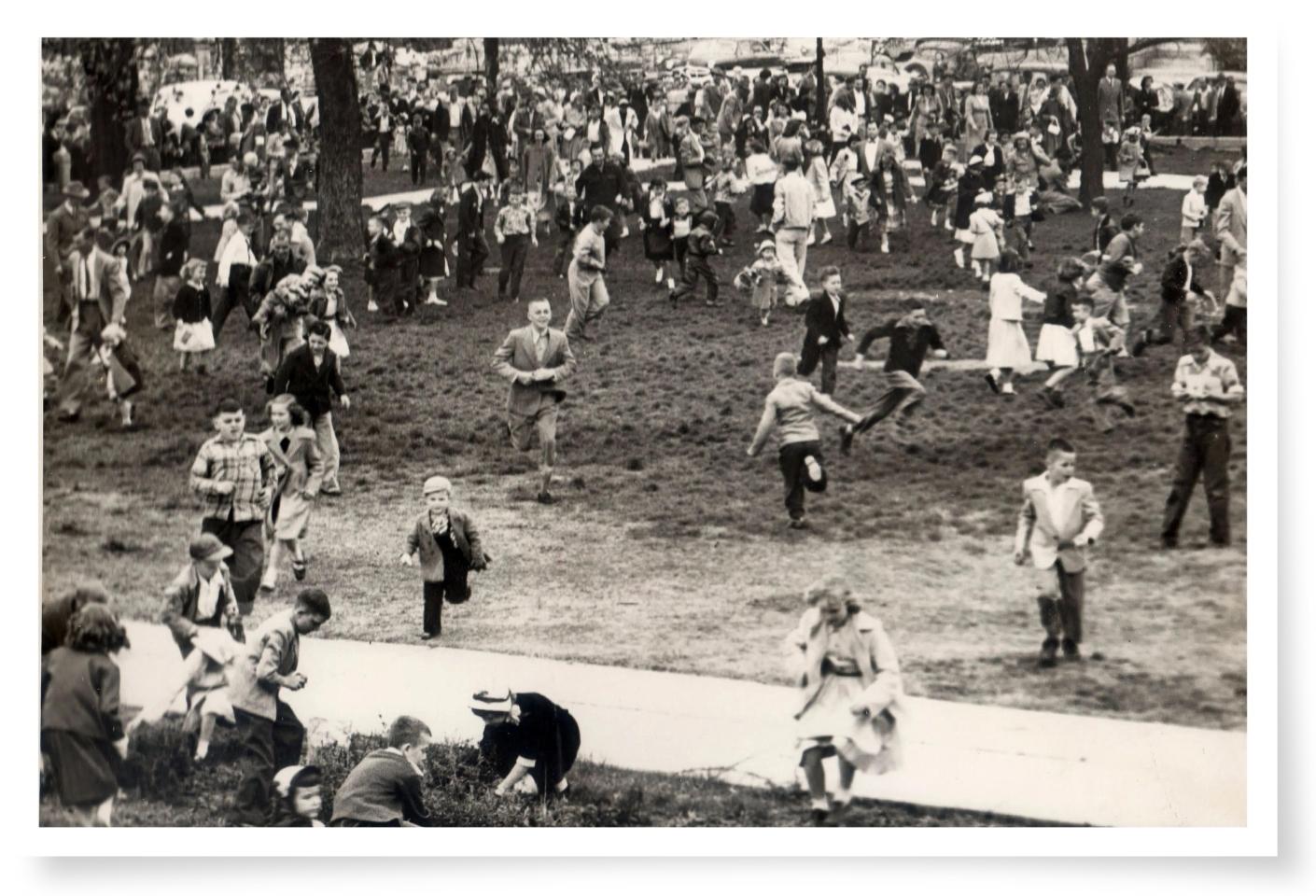
This photograph ran on the front page of the Kentucky New Era on April 6, 1953. Like today, it was a Monday, and also like today, it was the day after Easter. This massive crowd congregated for the sixth annual Easter egg hunt sponsored by the Hopkinsville Moose Lodge No. 1029. Approximately 1,500 young egg hunters and an additional 1,000 adults gathered in Virginia Park at Ninth and Campbell streets on Easter afternoon. Bill Moore caught this view and all its drama from the park’s bandstand. This picture just oozes fun and good feelings.
Really take a close look at this one. There is so much happening! Kids are running in dead sprints. They are digging in the bushes and filling their hands, their pockets, and baskets. One youth appears to be examining what is in his hand — I’m sure in hopes that it is marked for a prize. But my favorite is the kid being carried like an unruly package in the left of the photograph. The Moose Lodge’s hard work was rewarded by the group’s enthusiasm.
Help us show a more inclusive picture
We’re looking for Easter photos from Hopkinsville’s Black community duing the 1950s. Help us provide a more representative picture of the entire community.
History of the hunt
Established in 1945 with 50 charter members, the Hopkinsville Moose Lodge No. 1029 boasted a membership of close to 200 when they hosted their first Easter egg hunt in 1947. According to the New Era, this event was believed to be the first community-wide Easter egg hunt in the history of the county. In its first year, the group prepared for 1,000 children with $300 worth of prizes. The turnout was almost twice what they anticipated. With their expectations far exceeded, the Moose Lodge started a new local tradition that would last more than a decade.
This event was not, of course, the first Easter egg hunt ever. This picture sent me down a rabbit hole (no pun intended) to learn more about the origin of Easter eggs and why we hunt them. Like so many customs connected to Christianity, the root of the Easter egg is likely linked to ancient pagan traditions. Eggs have long symbolized new life and rebirth during celebrations of spring. Christians applied this symbolism of the egg to Easter and the resurrection of Jesus, taking it a step further by likening the egg to the tomb from which Jesus arose.
Decorating eggs is believed to have started as far back as the 13th century. Eggs were a once forbidden food during Lent, so people would paint them and eat them on Easter to celebrate. As for the hunting of these fancy eggs, the most consistent origin story attributed the practice to Germans and specifically to Martin Luther.
But back to Hoptown in the 20th century. This Easter egg hunt was a big deal. Unlike today’s hunts with plastic eggs filled with candy, this one featured thousands of colored, hard-boiled eggs — a few of which were marked as prize eggs. In 1950, the Moose Lodge expected each of their 125 members to prepare and donate a dozen eggs. That’s 1,500 eggs! In 1953 (the year of our picture), only 40 — or 2.6% — were worthy of a prize. And the prizes were nice: bicycles, a juvenile police car, a scooter, dolls, doll buggies, tricycles, roller skates and more. I wouldn’t be surprised if there weren’t a black eye or two in the midst of the festivities!
Top prizes in 1953 went to Jerry Collins, who won a large bicycle, Donald Henderson, who won a small bicycle, and Jo Anne Baze, who at age 7 was the youngest winner of the day. She took home the miniature police car.
This explains why so few of the children in the picture are carrying Easter baskets. It was a quality over quantity game. Kids didn’t want all the eggs. They just wanted specific eggs. The good news is that the Moose Lodge also handed out upwards of 1,500 bags of candy each year. Even if you didn’t find a prize one, you got to leave with more than just a pocket or basket full of hard-boiled eggs.
The Moose Lodge — with major help from their Ladies Auxiliary — hosted their egg hunt for the final time in 1961 (after taking a year off). They used the fairgrounds and broke their own attendance records with 2,500 young hunters and a total crowd of 5,000. In 1962, the newspaper reported “Annual Hunt Discontinued” and cited funding issues as the main reason for its end.
While I was reading through the newspapers in the late 1940s and through the 1950s, I discovered a few other community Easter traditions. For years, the youth of Hopkinsville put on an Easter sunrise service on Belmont Hill. Sponsored by the Ministerial Association, the service brought together young people from a number of churches representing a variety of denominations. The Ministerial Association also held special unity services on Maundy Thursday and Good Friday each year.
But nothing seemed to show the spirit of the season and of the community more than the annual Easter Egg Hunt. As thousands gathered on such a special day, they celebrated and rejoiced together — even if the loudest hallelujahs were hollered for a prize egg.
A tale of two Hopkinsvilles
That was the story that I wanted to tell when I chose the picture as my inspiration for this month’s column. A story of community and fun and laughter and candy. If that is the story that you want, then stop reading now. But I hope you’ll stick with me because as I was going through the newspapers, the story changed on me in a way that I cannot ignore. So, here’s the part that I left out but that I need to tell and that we all need to acknowledge.
Announced on the front page of the April 4, 1947, edition of the Kentucky New Era with the headline “Largest Easter Egg Hunt In Local History Slated Sunday,” the inaugural community-wide program specified that “the event will be open to all white children of Christian County under 13 years of age.”
All white children.
I wish I could say that I was shocked by this detail. I really wasn’t. But seeing this reality in black-and-white took my breath away and made me look at this photograph in a completely different way.
What I was shocked by was that I hadn’t even noticed that there isn’t a single person of color visible in this photograph. I had just seen a bunch of people in an excited, joyful moment. This is how history has overwhelmingly been represented to me. Frankly, this is how history has been represented to all of us. But this picture was taken before Brown vs. Board of Education and 14 years before our schools desegregated. This event was segregated because this community was segregated. There were two Hopkinsvilles — even on what many of us celebrate as the holiest, most special of days.
- RELATED: Attucks science classroom illuminates a cherished chapter in Black history
- RELATED: Hopkinsville memorial service highlights bell hooks’ place in the world
This photograph cultivated such a nostalgic sense of community for me. That is, until I looked closer. It is still a fantastic image of joy and happiness, and it brings a smile to my face. But I now accept that it isn’t comprehensive of our entire community’s experience. I think this picture will make me look at all historic photographs with a more discerning eye. I hope it makes us all look at history with a more open and critical mindset, too.
And it really makes me want to know how our African American children spent their afternoon on Easter Sunday in 1953.
(Editor’s note: This photograph was originally printed in the Kentucky New Era. The image is now in the collection of William T. Turner.)
Alissa Keller is the executive director of the Museums of Historic Hopkinsville-Christian County. She’s a graduate of Centre College with degrees in history and English and of Clemson University/College of Charleston with a master’s degree in historic preservation. She serves on the Kentucky Historical Society and the Kentucky Museum and Heritage Alliance boards.
